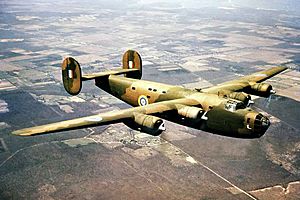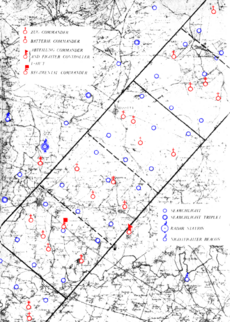Operations research facts for kids
Operations research (often called OR for short) is a special way of using math and science to help people make better decisions. Think of it like a toolkit full of smart methods to solve tricky problems. Sometimes, it's also called management science.
OR uses tools like math models, statistics, and finding the best possible solution to figure out the best or nearly best ways to do things. It's all about practical solutions! For example, it can help find the best way to make the most profit, get the best performance, or reduce costs and risks. OR started during World War II to help the military, but now it's used in many different industries.
Contents
What is Operations Research?
Operations research is about developing and using many different ways to solve problems. It helps make decisions better and improve how things work. Some of the techniques it uses include:
- Simulation: Creating a computer model to test different ideas.
- Mathematical optimization: Finding the best way to use resources.
- Queueing theory: Understanding waiting lines (like at a store or for a ride).
- Data envelopment analysis: Checking how efficient different units are.
- Neural networks: Computer systems inspired by the human brain.
- Decision analysis: Breaking down complex decisions.
Most of these methods involve building math models that try to describe a real-world system. Because it uses a lot of computing and statistics, OR is also closely connected to computer science. When someone in OR faces a new problem, they figure out which of these tools will work best. They might even invent a new tool if needed!
Some of the main areas in modern operations research are:
- Computers and information technology
- Financial engineering (using math in finance)
- Manufacturing, services, and supply chain management (how products get from start to finish)
- Planning for public services and government
- Revenue management (how companies set prices)
- Simulation
- Stochastic models (models that involve chance)
- Transportation theory (mathematics) (planning travel and shipping)
- Game theory (understanding strategies in conflicts or competitions)
- Linear programming (solving problems with straight-line relationships)
- Dynamic programming (solving problems by breaking them into smaller steps)
History of Operations Research
After the two World Wars, the tools of operations research started being used more widely in businesses, industries, and society. Since then, OR has grown into a field used in many areas, from oil companies to airlines, banks, and governments. It focuses on creating math models to analyze and improve complex systems.
Early Beginnings
Even in the 1600s, mathematicians like Blaise Pascal and Christiaan Huygens used ideas similar to OR to solve problems about chance and decisions. Later, in the 1800s, Charles Babbage studied how to make mail delivery cheaper, which led to England's "Penny Post."
Some people think modern OR started with inventory control (managing supplies) in the early 1900s. Others believe it began with military planners during World War I, who studied things like how to protect ships in convoys.
Modern operations research really took off in the UK in 1937. Scientists at the Bawdsey Research Station, led by Albert Percival Rowe, started using OR to improve the UK's early-warning radar system, called "Chain Home." They looked at how the radar equipment worked and even how the people using it behaved. This helped them find problems and fix them.
During this time, scientists in the UK (like Patrick Maynard Stuart Blackett and Solly Zuckerman) and in the US (George Dantzig) looked for ways to make better decisions in areas like logistics (moving supplies) and training schedules.
Second World War
The field of operations research truly grew during World War II. It was seen as a "scientific method" to give military leaders facts and numbers to help them make decisions.
During the war, nearly 1,000 men and women in Britain worked on operations research. About 200 OR scientists helped the British Army.
Patrick Blackett led a team called the "Circus" early in the war. They helped reduce the number of anti-aircraft artillery shells needed to shoot down an enemy plane. At the start of the Battle of Britain, it took over 20,000 shells. By 1941, it was down to 4,000!
In 1941, Blackett's team helped the Navy and RAF Coastal Command. His team included future Nobel prize winners. They did important studies that helped the war effort.
One big problem was how to protect ships from German U-boats. Britain used the convoy system, where warships escorted merchant ships. But was it better to have small convoys or large ones? Small convoys could travel faster and might be harder for U-boats to find. But large convoys could have more warships to defend them. Blackett's team showed that losses depended more on the number of escort ships, not the convoy size. So, a few large convoys were safer than many small ones.
Another study by Blackett's team looked at the color of aircraft used by RAF Coastal Command to hunt submarines. Most planes were black for night missions. But for daytime, tests showed that white planes were spotted 20% closer than black ones. This meant that if planes were white, 30% more submarines could be attacked and sunk! So, Coastal Command changed their planes to have white undersides.
Their work also showed that if depth charges (bombs dropped on submarines) were set to explode at 25 feet instead of 100 feet, more U-boats would be destroyed. This was because U-boats often didn't have time to dive very deep if they were spotted suddenly. It was better to attack them closer to the surface where their location was more certain. This simple change greatly increased the number of U-boats sunk.
Another famous story involves RAF Bomber Command. They surveyed bombers returning from Germany and found the most damaged areas. Their first thought was to add armor to these damaged spots. But Blackett's team realized this was wrong. The planes that returned had damage in those areas, meaning they could still fly home even with hits there. The areas that were never hit on returning planes were probably the vital ones. If those areas were hit, the plane wouldn't come back! So, they suggested putting armor on the areas that were untouched in the returning planes. This idea was also studied in the US by Abraham Wald.
OR also helped calculate how close bombers should fly in a "bomber stream" to minimize losses from collisions versus losses from German night fighters.
By comparing how many hours Allied planes flew to how many U-boats were spotted, OR helped move planes to more effective patrol areas. It also showed that groups of three US submarines were most effective for hunting targets. OR even found that glossy paint on night fighters was better camouflage and made planes fly faster!
On land, OR teams followed British forces in Europe after Operation Overlord in 1944. They studied how effective artillery, air bombing, and anti-tank weapons were.
After World War II
After the war, OR continued to grow. In 1947, Robert Watson-Watt (who helped start OR in the UK) said that OR's goal was "to check if the user is getting the best possible results from their equipment."
With new techniques and more awareness, OR wasn't just for military operations anymore. It expanded to include buying equipment, training, logistics, and building infrastructure. As computers developed, OR could solve problems with huge amounts of data. Today, OR is used in many areas, like city planning, sports strategies, emergency planning, and improving all parts of business and the economy.
Problems Operations Research Solves
Operations research helps solve many different kinds of problems, such as:
- Project planning: Finding the most important steps in a project that affect how long it will take.
- Factory layout: Designing the best way to arrange machines in a factory to save time and money.
- Network setup: Planning how to set up phone or power networks so they keep working even if parts break down.
- Resource allocation: Deciding how to best use limited resources.
- Finding locations: Choosing the best place for new buildings like warehouses or fire stations.
- Assignment problems: Matching people to jobs, or crews to flights, in the best way.
- Searching: Figuring out the best way to look for something, like a lost item.
- Routing: Planning the best routes for buses or delivery trucks to use fewer vehicles.
- Supply chain management: Managing the flow of materials and products, especially when demand is uncertain.
- Transportation: Managing how goods are shipped and delivered.
- Scheduling: Creating schedules for nurses, manufacturing steps, project tasks, or even sports events.
- Blending materials: Figuring out the best mix of raw materials, like in oil refineries.
- Pricing: Deciding the best prices for products and services.
- Cutting materials: Figuring out how to cut smaller pieces from larger ones with the least waste.
Operations research is also widely used in government to help make policies based on facts and data.
Management Science
Management science is closely related to operations research. It's about using scientific methods to help organizations make smart decisions. It uses math models, statistics, and computer methods to find the best solutions to complex problems.
Management scientists help businesses reach their goals by using scientific approaches. Their job is to use logical, systematic, and science-based techniques to improve all kinds of decisions. These techniques can be used not just in business, but also in military, medical, public administration, and community groups.
Management science focuses on creating and using models and ideas that can help understand and solve management problems. It also works on designing new and better ways for organizations to be excellent.
Related Fields
Many fields overlap with Operations Research and Management Science, including:
- Business analytics
- Computer science
- Data science
- Decision analysis
- Engineering
- Financial engineering
- Forecasting (predicting the future)
- Game theory
- Industrial engineering
- Logistics
- Mathematical modeling
- Mathematical optimization
- Probability and statistics
- Project management
- Queueing theory
- Simulation
- Supply chain management
- Systems engineering
Applications
Operations research and management science are used in many places, like airlines, factories, service companies, the military, and government. They help with a huge range of problems, such as:
- Scheduling flights, trains, or buses.
- Assigning crews to flights or employees to projects.
- Deciding the best place for new facilities like warehouses or fire stations.
- Managing water flow from reservoirs.
- Understanding and developing strategies for companies (using game theory).
- Designing cities.
- Planning and analyzing computer networks.
- Managing health services.
See also
 In Spanish: Investigación de operaciones para niños
In Spanish: Investigación de operaciones para niños
|
|
|
|
|



